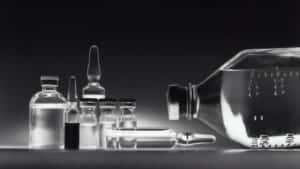With the COVID-19 outbreak on everyone’s minds, boosting our immune systems should be a top priority. Getting adequate sunlight, nutrition, sleep, water, and relaxation helps our bodies combat disease, and luckily, we can control these aspects of our health. Practicing breathing techniques, meditation and yoga can work wonders for lowering stress and boosting immunity.
Scientists have also discovered how red light therapy can help your body fight a virus.
What Is Red Light Therapy?
Red light therapy uses low-power red light wavelengths emitted through the skin. However, it doesn’t produce any heat, so the rays are not harmful. The skin can absorb red light up to a depth of eight to 10 millimeters and helps cellular energy as well as the nervous system and metabolic processes. Science classifies this light as a low level because it emits lower energy than other types of laser therapies.
If you’ve never heard of red light therapy, lightbox therapy is a form of it. Doctors utilize this method to treat seasonal affective disorder. Research is ongoing into red light therapy, but many scientists have found that it has virtually no side effects and can even provide anti-aging benefits.
A 2012 report published in Annals in Biomedical Engineering found that red light has the following benefits: “reduce inflammation, edema, and chronic joint disorders; to promote healing of wounds, deeper tissues, and nerves; and to treat neurological disorders and pain.” It also boosts immunity and life span by increasing cell migration and controls levels of cytokines and other inflammatory markers.
Benefits of Red Light Therapy
How can red light therapy improve our health? Studies prove that red light wavelengths can benefit our bodies in the following ways:
- Boosting energy levels by helping release ATP (adenosine triphosphate) from cells’ mitochondria
- Promoting DNA/RNA synthesis
- Boosts function of the lymphatic system which helps carry waste out of the body
- Increases blood flow and circulation, which allows oxygen flow throughout the body
- Forming new small blood cells
- Improving the natural production of collagen, which is used in skin repair, joint reparations, and digestive processes
- Decreases inflammation
- Lowers effects of free radical damage, which therefore reduces the risk of cancer and other illnesses
Below, we’ll go into more detail about how red light therapy can help your body during this pandemic. While taking care of your mind and body through relaxation techniques, and an overall healthy lifestyle is most important, red light therapy is a great addition.
Here’s how red light therapy can help your body fight a virus:
-
Boosts immunity and reduces side effects from chemotherapy
Research from NASA shows that red light therapy can benefit cancer patients by reducing side effects experienced from cancer treatments. Called HEALS, scientists use red or near-infrared light-emitting devices to release long wavelength energy to stimulate cells. NASA did a study to see if this treatment would help patients with oral mucositis, a common side effect of chemo. In the study, they found that 96% of patients saw a decrease in pain after being given the HEALS treatment.
Scientists stated, “The HEALS device was well tolerated with no adverse effects to bone marrow and stem cell transplant patients….The HEALS device can provide cost-effective therapy since the device itself is less expensive than one day at the hospital.”
Research is also being done to study how this technology could treat pediatric brain tumors, slow to heal wounds, diabetic skin ulcers, and third-degree burns.

-
Heals wounds and tissues
The light emitted in the range of 600 to 1,300 nanometers has been discovered to promote wound healing, tissue repair, and skin rejuvenation. However, it utilizes a different method of healing than conventional laser therapies. Most of the treatments today that dermatologists use involved intense pulsed light, which promotes skin rejuvenation by causing inflammation directly, which then leads to healing. The lasers damage the epidermis or dermis so that healing can later take place.
Red light therapy, however, doesn’t involve damaging the skin first and instead stimulates regenerative processes in the skin. It helps promote increased cellular migration and adhesion, which helps heal wounds and tissues. It may also treat skin conditions through the regeneration of fibroblasts and keratinocytes.
-
Increases joint and musculoskeletal health
Red light therapy proves to help arthritis symptoms by stimulating collagen production and repairing cartilage. A 2009 Cochrane review for low-level light therapy’s role in assisting rheumatoid arthritis found that “LLLT could be considered for short-term treatment for relief of pain and morning stiffness for RA patients, particularly since it has few side-effects.”
LLLT has also been found to help those who have tissue damage or age-related degeneration. A 2009 study published in The Lancet found that red light therapy can decrease pain immediately following treatment for acute neck pain and up to 22 weeks after treatment ends for patients with chronic neck pain.
-
Improved sleep
The human body needs exposure to natural light daily, preferably at sunrise and sunset, to regulate sleep cycles. Since most of us spend the majority of our days inside, throwing off our circadian rhythms and balance. This can lead to issues such as weight gain, fatigue, mood disorders, and insomnia. However, red light therapy can help regulate your sleep since it mimics natural sunlight. This will help reset your biological clock and balance melatonin levels.
It’s essential to get enough Vitamin D during this time, especially since scientists proved that sunlight helps reduce the risk of getting a virus.
-
Decreased depression and fatigue
Since sunlight boosts energy and reduces depression, it’s no surprise that red light therapy produces similar results. This study shows that one hour of light therapy can lower depression scores in those with seasonal affective disorder. Lack of sunlight can harm our immune systems, so it’s essential to expose our bodies to some sort of light each day. Light therapy is especially useful in the winter months when sunlight is scarce in most northern countries.
How to get red light therapy
You can do red light therapy from the comfort of your home using various devices. One is a light bed called TheraLight 360 HD. Many consider TheraLight the best and most potent option for consumers and businesses alike because you don’t need a healthcare license to buy one. It provides 10-15 minutes of red light therapy and has a 360-degree design for maximum exposure. It has one red and three near-infrared penetrating wavelengths, and you can control the frequencies and power with a wireless tablet.
Here are the health benefits according to makers of the device:
- Relief to joint pain and stiffness
- Temporary pain relief to minor arthritis pain or muscle spasm
- Increase in blood circulation
- A faster rate of recovery after injury
If you want something more affordable, Joovv might be a good option. Joovv light panels can help if you have insomnia or don’t have access to direct sunlight.
Side effects of red light therapy
Although scientists haven’t found many side effects associated with red light therapy, it may not be a universal answer to a lack of natural light. Scientists are still researching which light spectrums are most useful in treating various conditions and patients. In red light therapy, scientists have found that low doses are more helpful than higher doses. Some patients have reported side effects such as nausea, muscle weakness, dizziness, swelling, and burning, though these are rare.
Keep in mind that results vary from this type of therapy, and it might take a while to see the desired results.

Final thoughts about how red light therapy can help combat a virus
Red light therapy involves emitting red and near-infrared wavelengths through the skin to treat conditions such as depression, arthritis, insomnia, conditions caused by chemotherapy, and skin disorders. It helps boost cellular rejuvenation and increases blood flow, which boosts immunity. This can help your body fight off viruses and sickness in general. While side effects from this therapy are rare, results widely vary, and scientists are still studying the health benefits of red light therapy.
By emitting low-level waves through the skin, red light therapy may help with tissue therapy and other age-related degeneration of the skin. It helps boost collagen production, which is essential for processes such as skin rejuvenation, digestive health, and joint repair. Red light therapy has a positive effect on the immune and endocrine systems and can significantly aid in fighting off viruses. The FDA has even cleared treatment for conditions such as chronic joint pain and slow healing wounds.
As research grows regarding red light therapy, we can expect to see even more uses for this powerful natural remedy. As far as fighting off COVID-19, take the necessary precautions. Practice social distancing, washing your hands thoroughly after coming in contact with people or objects, and maintaining a healthy lifestyle.














 Community
Community

